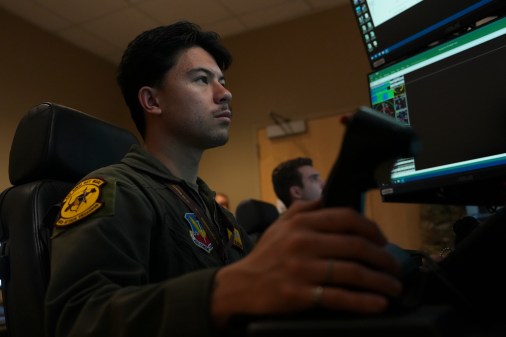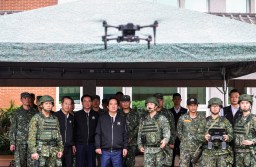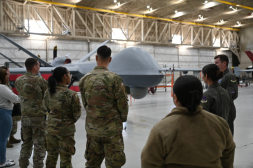Senators amplify concerns about pace of fielding AI-enabled counter-drone systems

The Senate Armed Services Committee wants answers from Army, Navy and Air Force acquisition executives about their plans to scale the fielding of autonomous counter-drone weapons for U.S. conventional forces.
A report accompanying the panel’s version of the fiscal 2025 National Defense Authorization Act, which was released this week, highlighted members’ concerns about where things stand.
“The committee believes that the most effective counter-unmanned aerial systems (UAS) capabilities for the joint force are those using software-defined technologies of autonomy, artificial intelligence (AI), and machine learning,” they wrote, noting that U.S. Special Operations Command has been using such technologies to rapidly deploy cutting-edge counter-UAS capabilities in combat environments. That includes multi-modal sensing capabilities and vertical take-off and landing, AI-driven autonomous air vehicles that can defeat “Group 3” drones — a category of UAS that includes loitering munitions, which are also known as kamikaze drones or one-way attack drones.
Industry has been developing cutting-edge systems, like Anduril’s Roadrunner-M, that are designed to perform air defense missions.
“The committee is concerned by the obstacles to transitioning these innovative capabilities from SOCOM to conventional forces,” and “the committee is concerned that the Services have not budgeted to sustain and expand these types of critical capabilities,” lawmakers noted in the report.
The legislation would require the acquisition executives for the Army, Navy and Air Force to provide separate briefings to the armed services committees on the Hill by Jan. 31, 2025, on their plans to “resource, transition, and scale advanced, AI-enabled, combat-validated UAS defeat capabilities to conventional forces within their department.”
The wording in the provision is very similar to a House-passed version of the annual defense policy bill, which makes it more likely that this type of directive will be included in the final version of the NDAA that comes out of the House-Senate conference process.
Autonomous air vehicles and tracking capabilities aren’t the only high-tech, drone-killing tools that lawmakers want to see the Defense Department prioritize and accelerate for fielding. They’re also keen on directed energy systems, a category of weapons that includes high-energy lasers and high-power microwaves.
DE tools are seen as a more cost-effective way of defeating large numbers of inexpensive drones, on a cost-per-shot basis, than many of the missiles or “kinetic” interceptors in the U.S. military’s arsenal.
In recent years, batches of UAS have been launched against Ukrainian forces and infrastructure by Russia, against U.S. Navy ships and commercial vessels in the Red Sea by the Houthis, and against American troops in the Middle East by other Iranian-backed groups.
“The committee remains concerned about the threat posed by low-cost attritable aerial drones, especially the threat that drone swarms pose to our forces. The committee notes that conflicts in Ukraine and the Middle East clearly demonstrate the utility and proliferation of low-cost attritable aerial drone systems and believes that more must be done to protect U.S. servicemembers from that threat. The committee welcomes the resulting increase in focus of the Department of Defense (DOD) on exploring the use of directed energy systems to defeat these threats at a low cost per engagement,” lawmakers wrote in the report for the SASC version of the policy bill.
“The committee encourages DOD to prioritize rapidly developing and acquiring directed energy systems to defeat large drone swarms and believes that the Department should utilize all available rapid acquisition pathways to develop and acquire directed energy counter drone swarm systems,” they added.
The Pentagon has been experimenting with these types of weapons and deployed some of them overseas, but not on a scale that some officials and advocates would like to see.
The Army has sent a 50-kilowatt laser system to the U.S. Central Command area of responsibility in the Middle East. Doug Bush, the service’s acquisition chief, said officials are getting important feedback from the effort.
“I think we’re learning a lot about the challenges of integration of that powerful laser system … on a vehicle versus doing it at a fixed site or versus doing a lower-power laser on a vehicle like a Stryker. So I think the learning that’s going on, though, is absolutely informing the [program objective memorandum] decisions being made, budget decisions being made right now in terms of what is most likely to succeed first in the directed energy realm. You know, beyond that, the fact that it’s deployed and being used by real soldiers, again, that’s just the best test we can have. I can’t get into more detail on effectiveness right now because of just security concerns,” Bush told reporters in June.
Meanwhile, Epirus has delivered prototypes derived from its Leonidas system to support the Army’s Indirect Fire Protection Capability-High-Power Microwave (IFPC-HPM) initiative. The Navy is also experimenting with the technology.
Some U.S. military leaders have expressed frustration that more DE systems haven’t been fielded. Other Defense Department officials have noted that there are still challenges to overcome, including command-and-command issues.
The SASC version of the NDAA would direct the secretary of defense to provide a briefing to the House and Senate armed services committees by Feb. 1, 2025, on all the department’s initiatives to develop and procure DE weapons that could defeat large numbers of enemy drones in a single engagement.
This week, SASC Chair Jack Reed, D-R.I., and Ranking Member Roger Wicker, R-Miss., announced that the committee’s NDAA was filed for the full Senate’s consideration.
“I am glad that this year’s NDAA makes important progress in a number of areas, including … significant support for technologies like counter-drone defenses and AI,” Reed said in a statement, before noting that he had to vote against the passage of the legislation because it includes authorization for a funding increase that can’t be appropriated without busting spending caps.
“I look forward to working with my colleagues in the Senate and House to find practical ways to strengthen this year’s defense bill,” he said.
In a statement, Wicker said he was “encouraged that many of my colleagues have joined me in the conversation about the need to invest more in our national defense. I look forward to discussing the peace through strength vision I have laid out in the months to come. This year’s NDAA results are a testament to the tradition of bipartisanship, vigorous debate, and good working order on which this committee prides itself.”






